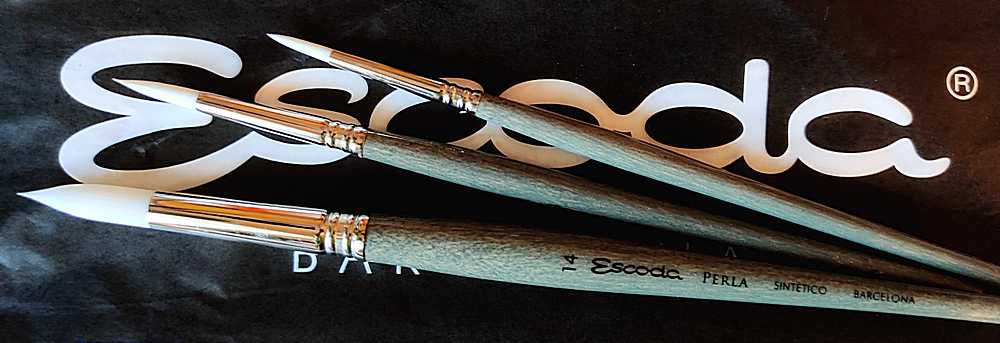Escoda Perla
April 1, 2024

One of my favorites among all watercolor painters is Joseph Zbukvic, he likes to use Perla from Escoda. In fact, so much so that Escoda markets a collection of Perla brushes under the name “Joseph Zbukvic Watercolor Set 1” which consists of Perla in sizes 8, 10 and 12 of which the size 10 is a travel brush.
Joseph Zbukvic also has other favorite brushes, which are also, for some reason, made by Escoda.
The brush sizes in the set are not that different from each other, they are quite similar. Why manufacturers always create their sets with such similar sizes, that they are almost interchangeable with each other, I do not know.
I instead bought size 4, 8 and 14, which in my opinion is a better distribution of sizes. Once I tried the brushes in a few paintings, I think the difference between 4 and 8 is too small, a better choice would probably have been 4, 10 and 16.
Perla is made of white Toray fiber, a synthetic fiber invented in Japan in the 70s. Toray fiber has a wide range of uses, not just for watercolor brushes. Brushes by Toray are quite common. One of my favorite Zahn brushes is made from these plus squirrel. What distinguishes Perla from other brushes made of the same material is that they are white. Which is nice before they have been used, but which become ugly when they are quickly stained by various pigments.
A disadvantage of Toray is that they do not have a great ability to hold liquid, despite what the manufacturer and various retailers claim. Perla is not a brush for large washes and fluid painting, choose another brush for such.
But the brush has a very fine tip and incredible elasticity, something that is achieved with different lengths and thicknesses of the straws in the same brush. Precision and accuracy are what distinguish Perla.

Very fine lines can be created with the brush. But be careful when painting fine lines. The brushes are very pressure-sensitive; just a little more pressure and your line will become thick. Precision may distinguish Perla, but the same applies to the artist who uses them.
If you want to draw a thin line with the brush, the pressure must be constant, the slightest deviation and the thickness of the line changes. This can be both an asset and a disadvantage. An asset when you want to make dynamic smaller surfaces but a disadvantage if you really need to make a fine line.

Anyone who likes to paint with dry brush technique will like this brush, because it is very good at it. I actually think it’s the best brush I’ve used for dry brushing.

Escoda Perla is a relatively inexpensive brush with fine qualities for precise painting; it’s possible to paint both quite roughly and very detailed with the brush. Perla doesn’t hold much liquid, making it unsuitable as an all-around brush. Large areas with a lot of paint don’t work well, but it excels at small items and details. Dry brushing gives excellent results.
The less common and rather attractive white color of the brush hairs disappears already after the first painting.












